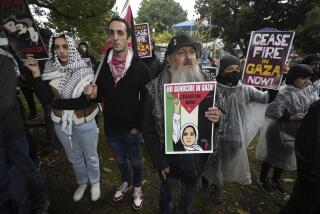The Chosen in the Promised Land : A HISTORY OF THE JEWS IN AMERICA, <i> by Howard M. Sachar (Alfred A. Knopf $40; 1051 pp.)</i>
Howard M. Sacharâs hefty volume, âA History of the Jews in America,â is both more and less than one might have hoped for. Its subject is one that demands a large overview, and it is a subject that is definitely of interest at least to Jews, and probably to others as well. But there is a glaring error in Sacharâs focus--he places too much emphasis on the history created by the machers and shakers in the synagogue and federation worlds--people, who, truthfully, have had little truck with the great Jewish minds that really created all that is vibrant in Jewish culture.
This has been the case ever since Baruch Spinoza was excommunicated for heresy a few centuries back. Ironically, one of the more appealing things about Jewish culture is the fact that the hierarchy of the organized community generally has no power to excommunicate. The real inspiration of the Jewish people has often come in opposition to the organized community--not at its behest. In a couple of places Sachar comes dangerously close to transforming the most successful fund-raisers into heroes equivalent to the greatest Jewish scientists, philosophers and artists.
Sachar goes on interminably tracing the differences between the American Jewish Committee and the American Jewish Congress--differences that in the beginning were perhaps quite considerable, but now are fairly minuscule. The resourcefulness Jewish immigrants showed in developing defense and communal organizations of all kinds is not to be overlooked; still, it isnât the most vibrant aspect of the Jewish saga.
Luckily, Sachar does little pontificating on the time-honored questions; e.g., âAre Jews a nation, a culture, a people, or a religion?â And none of this is to deny that Sachar doesnât come up with some trenchant points about the organized community. He is quite happy blasting the Simon Wiesenthal Center, for instance. An Orthodox version of the Anti-Defamation League that is based here in Los Angeles, the center, Sachar writes, is ânamed after a widely known and even more widely overrated Nazi hunterâ and is âthe brainchild of a publicity-wise former New York rabbi, Marvin Hier.â
Sachar also quotes from a variety of critics who have suggested that the focus on the Holocaust and Israel by the organized Jewish community has created a kind of Judaism without substance--which is not the same as the religion that has survived for as long as it has by basically satisfying a peopleâs âdeepest existential needs.â Sachar notes that one scholar has gone so far as to suggest that the Jews will disappear as a result of intermarriage and âIsraelodolatry.â
He quotes in full one speaker at an annual assembly of the Council of Jewish Federations, who actually declared: âWe are Jews, with both a millennial experience in dealing with a hostile world and with immense new capabilities for forging our own destiny rather than being, as we were for centuries, puppets of history, manipulated by others . . . Does anyone think . . . that there is a separation . . . between Jewish fund-raising and Jewish identity? Fund-raising is profound Jewish expression. It is Jewish culture.â Given the fact that even pious Jews are not required to take the traditional Christian vows of poverty, nevertheless Jewish history--including American Jewish history--is full of cases of people doing things not because they were profitable, but because they were good and necessary in and of themselves.
Sachar certainly hasnât the imagination or writing talent that Irving Howe showed in âWorld of Our Fathers,â or the transcendent quality of Nobel Prize-winning Elie Wiesel, who obviously bothers him intensely. Sachar, a respected academic and author of other volumes on Jewish history, divines that Wieselâs writing exhibits a style âwhich strikes many readers as timeless and important,â but he will only grant that âin negotiating a merger of the Holocaust industry with the mysticism vocation, Wiesel might have been staking out a high assay lode of vast entrepreneurial potential.â
Sachar sometimes trivializes the American part of this ancient peopleâs venerable history by indulging in too much braggadocio about which scientist, writer, musician, financier or businessman was Jewish. Still, the stories of Joseph Pulitzer, Adolph Ochs, George Gershwin, Aaron Copland, David Sarnoff, and Carl Laemmle to mention just a few, do seem to argue that Jews have prospered in America like they have nowhere else save Babylon.
Sachar is more interesting when he comes to political history. He does a good job of recording those grand historical moments, such as when President Abraham Lincoln told Isaac M. Wise, founder of Reform Judaism in America, that âI am blood of your blood, flesh of your fleshâ--and his volume is full of folks such as Levi Strauss and Adolph Sutro, every bit as much pioneer aristocrats of the Old West as the original gold mining Hearst. He captures the incredible widespread anti-Semitism of 19th and 20th Century America as well, which typically painted âthe Jewâ as âdirtyâ and âgreasy,â either cringing or âstrutting with the air of a millionaire,â inclined to criminality.
Donât the names of Jewish ghetto gang leaders such as Bald Jack Rose, Whitey Lewis, Lefty Louis, and Gyp the Blood, who butchered each other during Tammany Hallâs control of New York City in great turf wars for brothels and opium dens, suggest something of South Central Los Angeles today? At the beginning of this bloody century, books and articles frequently referred to Jews and corruption, and talked about notorious gangs of Jewish firebugs,â the âOriental cunningâ of Jews, and âthe criminal instincts that are so often found naturally in the Russian and Polish Jews.â
Images of the Jewish immigrants in the American press at the turn of the century were often unflattering, rarely objective. The New York Tribune reported that immigrant Jews were âfilthy in their habits and most obstinate in their mode of living. They persist in keeping live fowl in their rooms . . . (are) accustomed to taking only one bath a year . . . are utter strangers to soap and water . . . are on social terms with parasitic vermin.â
(Later, ironically, in talking about the marginal industries Jews were allowed to dominate, mostly because Gentiles would have nothing to do with them, Sachar reports that Jews eventually owned more than half of the nationâs largest insect exterminating companies--because Jewish law stressed the importance of hygiene and sanitation. Throughout the Middle Ages, in fact, âJews devoted much attention to the eradication of verminâ while Christians gave âlittle heed to plagues and pestilence, regarding these afflictions as punishment for sins.â)
Sachar vividly details the interplay of the Sephardim (the Spanish and Middle Eastern Jews), the Germans, and the East Europeans over the years. He strongly delineates the wars between the Zionists and non-Zionists, the socialists, the Orthodox, and the Yiddishists. He also devotes considerable space to an analysis of which U.S. presidents were good for the Jews, and which were not.
The list of those who were most sympathetic includes Lincoln, Grant, Wilson, both Roosevelts, Truman and Kennedy. He talks about Roosevelt and Truman at longer length. Roosevelt genuinely admired Jews and opposed anti-Semitism. When at the bottom of the Depression he put together his âbrain trustâ to save the country, he said âDig me up 15 or 20 youthful Abraham Lincolns from Manhattan and the Bronx to choose from. They must be liberals from belief, and not by lip service . . . They must know what life in a tenement means. They must have no social ambitions.â Many Jews found employment in the Roosevelt administration, a fact anti-Semites like Father Coughlin and Gerald L.K. Smith rarely failed to mention.
On the other hand, despite the incredible love of Roosevelt among his generation of Jews, everyone knows there has been some reevaluation of him because of his sometimes murky role in offering haven to the Jewish Holocaust survivors in Europe. Sachar says that most of this was due to Rooseveltâs well-deserved fear of the rampant anti-Semitism in the Depression years. Roosevelt was always nothing if not a pragmatic president.
To my mind, Sachar panders too much to the âNew York intellectualsâ--the Norman Podhoretz gang, primarily, who became neoconservatives in the Reagan era. He writes about them as if they were in some way equal to the level of the Roosevelt brain trusters. Far more powerful than the pages wasted on the âNew York intellectualsâ was Sacharâs recounting of a scene from Bernard Malamudâs 1971 novel, âThe Tenants,â in which a Jew and a black lunge at each other in an orgy of uncontrolled fury. The black, named Spearmint, yells: âBloodsuckin- JewNiggerhater.â And the Jew Lesser replies his nastiest retort: âAnti-Semitic Ape.â Stripped of all fancy verbiage, here are a Jew and a black expressing their worst fears and beliefs about each other in elemental terms.
As painful as that is, at least here Sachar is dealing with the stuff of which history is made. Human passions, actions and expressions are that stuff, and there is a goodly amount in these pages. Just not enough. For the enthusiastic reader, Sacharâs volume is like the offering of a big meaty bone to a hungry dog. It isnât necessarily a complete disappointment just because it isnât chateaubriand.
More to Read
Sign up for our Book Club newsletter
Get the latest news, events and more from the Los Angeles Times Book Club, and help us get L.A. reading and talking.
You may occasionally receive promotional content from the Los Angeles Times.







